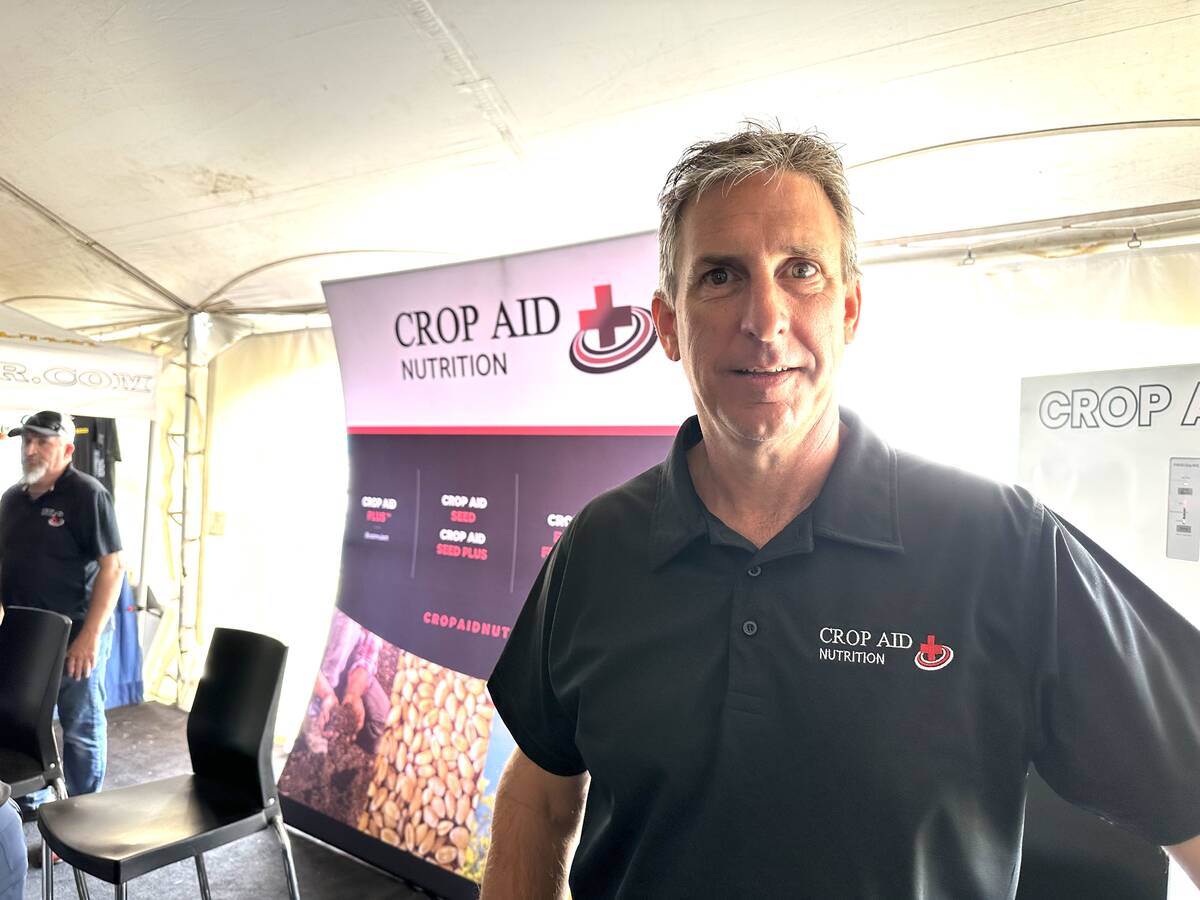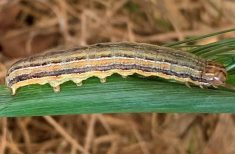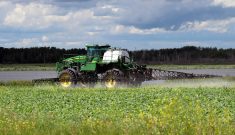Prairie farmers are welcoming the return of some important insecticides to the crop protection toolbox — although there’s still some headshaking over why use of the products was interrupted in the first place, and why it took two years for the federal Pest Management Regulatory Agency (PMRA) to re-evaluate registration data.
Although producers such as Dallas Leduc and Corey Loessin in Saskatchewan and Roger Chevraux in Alberta appreciate the fact they can now again use Syngenta and Adama products with lambda-cyhalothrin chemistry to control insect pests on cereal, pulse, corn and canola crops, they say it’s been a tense and somewhat expensive past couple of growing seasons without use of the effective and affordable insecticides.
“We got through the past couple years without any major wrecks,” says Roger Chevraux, who farms at Killam in central Alberta, east of Camrose. “We did have alternate products available, but the issue is when the registration of lambda-cy products changed we had very little notice. If we had had a serious outbreak of some pests it could have been a disaster.”
Read Also

New soil treatment targets saline patches in fields
Crop Aid SS is a Saskatchewan-made spray that’s intended to help farmers manage saline soils by leaching salts away from the root zone.
Corey Loessin, a grain, oilseed and pulse crop producer at Radisson, Sask., credited commodity organizations such as the Canada Grains Council and others for their efforts in encouraging PMRA to review current data that helped to reinstate lambda-cy registration for major crops.
And Dallas Leduc, who farms at Glentworth, says grasshoppers didn’t take a break during drought conditions in his part of southern Saskatchewan. Fortunately he was able to use another insecticide — Coragen, with the active ingredient chlorantraniliprole — which was effective but considerably more expensive than lambda-cy products.
As well, he did discover a cost-effective, made-in-Saskatchewan insecticide that also has become another tool in his crop protection toolbox.

The background
At issue for these and other Canadian farmers was a decision by Health Canada’s PMRA in mid-February 2023 to change the registration of insecticides containing lambda-cy chemistry, saying those products could no longer be used on major crops such as cereals, pulses and canola — if those crops were being used for livestock feed. Lambda-cy could still be used on crops to be processed for the human food market.
The ruling followed a routine review of pesticides in both the U.S. and Canada, which started some years before. PMRA made its determination due to concerns about insecticide residue levels found in livestock feed.
Ultimately the existing lambda-cy products, such as Matador 120 EC and Voliam Xpress from Syngenta, as well as Silencer and Zivata insecticides from Adama, remained available for food crops, with their labels adjusted accordingly.
But as the agriculture industry knows, crops seeded in April and May might very well be intended for human food products, a plan that could quickly change depending on growing season conditions, markets and crop quality at harvest. Any of the major crops could very well end up as part of some livestock ration.
Fast forward to earlier this month: after reviewing the most current research data regarding pesticide residues, PMRA reversed its decision and reinstated the use of pesticides containing lambda-cy chemistry on major crops used for both food and livestock feed.
The 2025 ruling does have a couple of limitations. Lambda-cy products can no longer be used on peach and apple crops. Lambda-cy can be used, but with reduced application, on turf grass — but it still cannot be used on any crops produced for livestock forage, whether that be grazing, greenfeed, hay or silage.

The 2023 scramble
“The PMRA ruling was made in mid-February of 2023, which didn’t leave chemical companies or farmers much time to line up alternate products for that season,” Chevraux recalls.
“And the ruling itself made zero sense. Why could the products be used on and be OK for food use but not for feed? It just didn’t add up.”
Chevraux, a past chairperson of Alberta Canola, says he doesn’t always need to use an insecticide — but in the spring of 2023 he did have a problem with cutworms on his farm.
“Fortunately we found another product that helped control cutworm, but it cost four times as much as the lambda-cy products,” he says. “We did have some flea beetles, but it wasn’t serious. We were just lucky there wasn’t an outbreak of grasshoppers or diamondback moths or some other pest that can blow in from the U.S.
“I get concerned any time we lose a tool from the toolbox, because in agriculture we need as many choices as possible in order to optimize production,” he says. “I believe PMRA needs to operate in a more timely manner. The agency needs more funding, and I don’t believe the agency has a good understanding of the agriculture industry, our modern production practices and some of the issues or challenges the industry faces in any given year.”

More responsive PMRA
Loessin says farmers in his area northwest of Saskatoon fortunately also didn’t have any major insect outbreaks during the 2023 and 2024 growing seasons, and they did have access to alternatives as needed.
“I’m glad that use of lambda-cy products on crops used for livestock feed has been reinstated,” says Loessin. “But in my view, it just corrects a mistake that shouldn’t have been made in the first place. It appears that PMRA was relying on old data when it made that ruling in 2023, even though there was new or more current data available.
“Commodity organizations actively encouraged PMRA to reconsider and review the new data which eventually led to the products being re-instated for use. The initial review started in 2017 and now it is 2025 — that’s a long review process.
“In general I believe PMRA needs to be more responsive. It took two years from 2023 until now to review the data and reinstate these insecticides. What if it had been the opposite issue — there was chemistry in use that was causing harm to human health or the environment? Would we have to wait two years for that product to be pulled from the market? I’m glad the lambda-cy products are back but I really think PMRA needs to be more nimble and more responsive in its review process.”
Good to have alternatives
Although Leduc says he was able to use alternate products to control insect pests — namely grasshoppers — on his southern Saskatchewan farm, he’s glad to see products containing lambda-cy can again be used on cereals, pulses and oilseeds for both food and feed markets.
“Coragen is a great product, but it is more expensive,” he says. “Depending on the pest and the year sometimes we have to treat whole fields or sometimes just the edges or the headlands. We went into the fall of 2024 with no subsurface moisture so I know that grasshoppers will be a problem again in 2025.”
One other grasshopper control option Leduc discovered over the past couple of years is Eco-Bran. Developed about 40 years ago by Peacock Industries of Saskatoon, it’s a bait made of wheat bran infused with carbaryl insecticide.

Leduc says his spot application system uses a hopper with a fan powered by a five-horsepower Honda engine, mounted in his pickup truck.
“We found that sometimes we just want to treat the ditches or the headlands, or just around the yard for grasshoppers,” he says. “And some of our land is up to 30 miles away. We can mount the blower in the back of the pickup truck, drive 30 minutes to the field, put the Eco-Bran in the hopper and blow the product out in the ditch or along the edge of the field and then drive home. It is a lot simpler than taking a sprayer that costs a few hundred thousand (dollars) and bouncing it along for 30 miles for a 20-minute spraying job.”
What’s more, “it works, too,” he says. “The grasshoppers eat that bran and they’re dead. It doesn’t eliminate them, but it does help to control them. It is environmentally friendly and an effective way to treat strips or patches.”
Eco-Bran comes in a 20-kg bag that retails for about $147.
A cautious approach
Manitoba Agriculture entomologist John Gavloski says the pesticide review process can sometimes result in restricted uses of popular pest management options — but it’s a safeguard against product uses where there’s evidence of potential harm to the environment or human health.
PMRA, he says, wants to make sure insecticides used at recommended label rates do not exceed maximum residue levels in our foods.
“The PMRA is taking a cautious approach when it comes to regulating the uses of lambda-cyhalothrin,” he says. “There was some concern that residuals in some foods were found to be above what is considered safe levels. Now PMRA has reviewed new information and determined that some restrictions on the use of seeds from some major field crops being used for livestock feed can be lifted.

“However, PMRA still has concerns about these crops being used as forages, so the restrictions for that end use is still in place.
“Overall it is good news for farmers, in that they can use these effective insecticides on major crops, such as canola and some cereal and pulse crops, without concerns around marketing grain from these crops.”
Gavloski notes lambda-cyhalothrin use also remains cancelled for sunflowers, which took up about 44,900 acres in his province in 2024, down 47 per cent from 2023.
“Unfortunately, there aren’t a lot of insecticide options that can be used to control lygus bug in sunflowers, but producers and the industry were able to obtain emergency registration of an alternate product that could be used,” he says — a reference to Carbine, a flonicamid product sold in Canada by FMC. That emergency registration is still in effect in Manitoba, and for confection sunflowers only, but is set to expire July 20.
“There are now efforts to obtain full registration for this product for use with sunflowers. On the positive side, this new product is very selective in controlling lygus bug and other sap-feeding pests and will not harm beneficial insects. So that is perhaps also a good outcome of this review process.”

System needs a review
Shannon Sereda, senior manager for government relations and policy with Alberta Grains, says Alberta farmers are no doubt pleased with the recent decision by PMRA — but it underscores a need to look at the whole process of how pesticides are reviewed.
“As everyone says, it is great to have another valuable tool back in the crop protection toolbox,” Sereda says. “This is what Alberta Grains was advocating for all along and it is the outcome we had hoped for.
“But it emphasizes the need for industry to work with PMRA on hopefully revising and modernizing the whole pesticide review process. The process takes years and to have restrictions like this imposed for two years creates a lot of confusion for producers.
“The decision which separates food from feed is a very complex issue for farmers. Often the decision regarding the end use of crops isn’t made until long after a pesticide has been applied. So we feel it is important in making future decisions that PMRA understands the complexity or the ramifications of their decisions and importance of timeliness. These are some of the concerns we as a sector will be looking at with the PMRA review process.”
The issue with lambda-cy also emphasizes a long-talked-about need for harmonizing the whole crop protection product registration process among like-minded jurisdictions and markets.
U.S. authorities, for example, had reviewed data and found lambda-cy products fell within food and feed safety guidelines, whereas PMRA had to conduct its own review and evaluation.

The issue with the part of the PMRA decision that restricts the use of lambda-cy on forage crops remains up in the air. However, one southern Alberta agronomist says it may not have a huge impact.
George Lubberts, owner of Complete Agronomic Services at Nobleford, north of Lethbridge, says irrigated cereal crops grown for pasture, greenfeed or silage usually aren’t treated with pesticides, although pests such as grasshoppers can be a concern for dryland farmers, especially in dry growing seasons.
“Among my clients, I believe the restrictions in pesticide use might be a concern for dairy producers looking to control alfalfa weevil in alfalfa crops, but there are other products available,” he says.
















